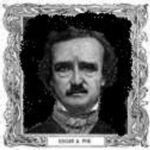Throughout history, art has been used to reflect society.Literature, in particular, is often used to represent the negative side of life. Edgar Allen Poe’s microcosmic “The Masque of the Red Death” is one such work. A story of a group’s attempt to escape the plague that is devastating the countryside, Poe
focuses on the ironic, yet morbid, theme of the characters’ having walled in death in a frenetic attempt to wall it out (Thompson 123). The author uses the characters, imagery, and setting of the story to portray his own dim view of society.
Ignoring the plague that is sweeping across the land, Prince Prospero withdraws into the seclusion of one of his castellated abbeys with the thought of escaping the “Red Death.” Despite the problems of the outside world,”the Prince Prospero was happy and dauntless and sagacious”(Poe 75). A kind of “demigod,” Prospero can create his own world, and he can people it, but time still exists (Ropollo 140) and death must inevitably follow.
As the story unfolds, it becomes apparent that its people, dressed in their elegant clothing, are “eminently human, fashioned like the inhabitants of the macrocosmic world” (Ropollo 140). Fearing the plague that is devastating the countryside, and desiring an environment in which they can indulge their fancies, the prince and his guests lock themselves behind the abbey walls, creating thereby the conditions of their “own premature burial”(Halliburton 308). Like any faced with a problem, these characters try to pretend that it does not exist.”The revelers are the living, who seek to bar out death by being gay and carefree, only to discover that death must inevitably conquer all humanity”(Ropollo 138). Despite the prince and his party’s efforts to create a more perfect world, time still exists and, no matter what they do to escape, death will eventually take them.
In the end, the characters’ efforts prove to have been in vain, for in spite of their having withdrawn from the rest of the world, there arrives a new character.”The figure was … shrouded from head to foot in the habiliments of the grave. The mask which concealed the visage was made so nearly to resemble the countenance of a stiffened corpse that the closest scrutiny must have had difficulty in detecting the cheat”(Poe 79). The strange figure is symbolic of the afterlife and his coming means the end of the masquerade:the end of life (Hammond77).
Having walled themselves in and the “Red Death” out, the characters dance the night away, oblivious to the problems of the outside world, when suddenly,” there strikes the ebony clock…And then, for a moment, all is still, and all is silent save the voice of the clock”(Poe 78). The clock brings the revelers back to reality, giving them ” a premonition that the end for them draws ever closer”(Hammond 78). It is the clock which symbolizes time, the one reminder that they cannot escape the “Red Death,” a term Poe uses to represent death itself.Ropollo states,”The Red Death is not a pestilence in the usual sense; it is unfailingly and universally fatal, as no mere disease can be; and blood is its guarantee, its avatar and seal. Death itself, then, is the Red Death, the one affliction shared by all mankind”(139). Through his use of symbolism, Poe once again calls to the reader’s attention the horrid truth that death is inevitable.
The setting of “The Masque of the Red Death,” with its seven rooms, also plays an important role in the story. In the seclusion of the abbey, the revelers envision themselves to be safe from the deadly pestilence outside its iron gates.”It was folly to grieve, or to think. The prince had provided all the appliances of pleasure…All these and security were within. Without was the `Red Death'”(Poe 76). The characters make their way through the seven rooms, which, Walter Blair describes,”progressing from east to west, from blue to black, connote the seven ages of man from the blue of the dawn of life to the black of its night”(rpt. in Ropollo 138). All of the rooms are life (140), and “in six of the seven rooms, the heart of life beat feverishly”(Poe 79). But the seventh room, the black room, is the end of life; it is where time (the ebony clock) runs out and death occurs.
Through his use of characters, imagery, and setting, Poe mocks society. He portrays the gruesome, yet inevitable truth: that death and disease cannot be locked out or ignored, that everything endowed with life dies “and, with the last of them, time, which is measured and feared only by man, dies, too” (Ropollo 140).
Works Cited:
Halliburton, David. Edgar Allen Poe: A Phenomenological View. Princeton: Princeton U P, 1973.
Hammond, J.R. An Edgar Allen Poe Companion. NJ: Barnes, 1981.
Poe, Edgar A. The Tales of Edgar Allen Poe. Pittsburg: Franklin, 1974.
Ropollo, Joseph P.”Meaning and `The Masque of the Red Death.'” Poe: A Collection of Critical Essays.”Ed.Robert Regan. Englewood Cliffs, NJ: Prentice, 1967.
Thompson, G.R. Poe’s Fiction. Madison: U of Wisconsin P, 1973.




